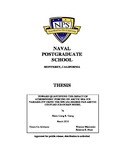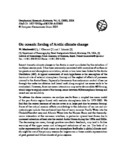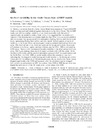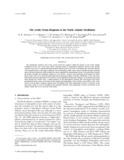Toward quantifying the impact of atmospheric forcing on Arctic sea ice variability using the NPS 1/12 degree pan-Arctic coupled ice-ocean model
| dc.contributor.advisor | Maslowski, Wieslaw | |
| dc.contributor.advisor | Stone, Rebecca E. | |
| dc.contributor.author | Tseng, Hsien-Liang R. | |
| dc.date.accessioned | 2012-03-14T17:45:21Z | |
| dc.date.available | 2012-03-14T17:45:21Z | |
| dc.date.issued | 2010-03 | |
| dc.identifier.uri | https://hdl.handle.net/10945/5416 | |
| dc.description.abstract | The rapid Arctic sea ice decline since the 1970s has propelled the United States into a state of urgency for updating its defense plan as Arctic and non-Arctic nations alike are taking an interest in the newfound natural resources of an ice-declining Arctic. In line with the National Security Presidential Directive-66, we quantify the amount of anomalous sea ice variability (aSIV) that anomalous atmospheric forcing parameters explain using partial covariance analysis. A one-system approach where the NPS Model sea ice parameters are the direct output of the atmospheric forcing parameters input is employed. Atmospheric forcing fields of 2-m temperature, downward shortwave and longwave fluxes, 10-m zonal and meridional winds and stresses, are from the European Centre for Medium-Range Weather Forecasts Reanalysis-15 and Operational Products. Locations of interest are the Central Arctic seas, and locations along the Northwest Passage (NWP) and the Northern Sea Route (NSR). Results show that the atmospheric parameter having the largest influence on aSIV is anomalous surface air temperature. This occurs during the cooling months and averages 4-39% of aSAT contribution to aSIV in the Central Arctic, 9-16% along the NWP, and 11-25% along the NSR. Results also suggest that atmospheric forcing alone does not explain all of aSIV. | en_US |
| dc.description.uri | http://archive.org/details/towardquantifyin109455416 | |
| dc.format.extent | xxvi, 169 p. : ill. (color) | en_US |
| dc.publisher | Monterey, California. Naval Postgraduate School | en_US |
| dc.rights | This publication is a work of the U.S. Government as defined in Title 17, United States Code, Section 101. Copyright protection is not available for this work in the United States. | en_US |
| dc.subject.lcsh | Meteorology | en_US |
| dc.subject.lcsh | Oceanography | en_US |
| dc.title | Toward quantifying the impact of atmospheric forcing on Arctic sea ice variability using the NPS 1/12 degree pan-Arctic coupled ice-ocean model | en_US |
| dc.type | Thesis | en_US |
| dc.contributor.corporate | Naval Postgraduate School (U.S.) | |
| dc.contributor.department | Meteorology | |
| dc.contributor.department | Physical Oceanography | |
| dc.description.service | US Air Force (USAF) author | en_US |
| dc.identifier.oclc | 610058968 | |
| etd.thesisdegree.name | Master of Science in Meteorology | en_US |
| etd.thesisdegree.name | Master of Science in Physical Oceanography | en_US |
| etd.thesisdegree.level | Masters | en_US |
| etd.thesisdegree.discipline | Meteorology and M.S. in Physical Oceanography | en_US |
| etd.thesisdegree.grantor | Naval Postgraduate School | en_US |
| etd.verified | no | en_US |
| dc.description.distributionstatement | Approved for public release; distribution is unlimited. |
Files in this item
This item appears in the following Collection(s)
-
1. Thesis and Dissertation Collection, all items
Publicly releasable NPS Theses, Dissertations, MBA Professional Reports, Joint Applied Projects, Systems Engineering Project Reports and other NPS degree-earning written works.





